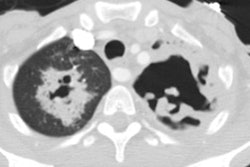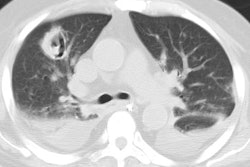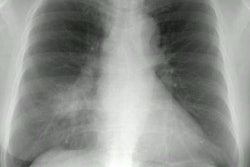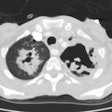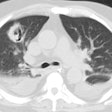Clinical and radiographic manifestations of uncommon pulmonary nontuberculous mycobacterial disease in AIDS patients.
El-Solh AA, Nopper J, Abdul-Khoudoud MR, Sherif SM, Aquilina AT, Grant BJ
STUDY OBJECTIVE: To determine the clinical and radiographic findings of nontuberculous mycobacteria (NTM) other than Mycobacterium avium complex (MAC) and Mycobacterium kansasii in AIDS compared with non-AIDS patients. DESIGN: A retrospective chart review of all patients in whom NTM other than MAC complex and M kansasii were isolated between April 1, 1989, and October 31, 1995. SETTING: University-affiliated hospital. PATIENTS: Fifty-four patients met the criteria for uncommon pulmonary NTM disease: (1) repeated isolation of atypical mycobacterium in colony counts of > or = 3 from two or more sputum specimens; or isolation of the organism from transbronchial or open lung biopsy specimen with histologic changes suggestive of mycobacterial disease in the absence of other pathogens; and (2) either an abnormal chest radiograph, the cause of which had not been attributed to an active infection other than atypical mycobacterial disease; or the presence of one or more symptoms indicative of pulmonary disease coupled with exclusion of other illnesses with similar symptoms and signs. RESULTS: Thirty-five patients were HIV positive. Fever was the only clinical symptom more commonly seen in HIV-infected patients with NTM than non-HIV-infected patients. Sixty-six percent of all patients with AIDS were infected by Mycobacterium xenopi. Chest radiographs of AIDS patients showed a tendency for predominance of interstitial infiltrate and rarity of fibronodular disease. No specific radiographic pattern was observed for any particular organism. Adenopathy was not a feature of uncommon pulmonary NTM in AIDS, and it should suggest an alternate diagnosis. In two patients, NTM isolation from respiratory specimens preceded dissemination. Six of 8 AIDS patients treated for pulmonary NTM remained alive at the end of the study compared with only 4 of 15 patients who were not treated for pulmonary NTM (p<0.05). CONCLUSIONS: Uncommon NTM isolated from respiratory specimens ought to be considered as serious pathogens in the presence of clinical and radiographic manifestations unexplained by other pathologic processes. Colonization with NTM could precede dissemination. Treatment of uncommon pulmonary NTM disease could possibly confer a survival benefit in AIDS patients.
